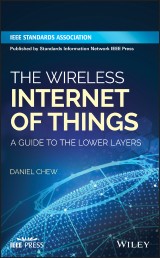Details
The Wireless Internet of Things
A Guide to the Lower Layers1. Aufl.
|
96,99 € |
|
| Verlag: | Wiley |
| Format: | EPUB |
| Veröffentl.: | 10.10.2018 |
| ISBN/EAN: | 9781119260592 |
| Sprache: | englisch |
| Anzahl Seiten: | 208 |
DRM-geschütztes eBook, Sie benötigen z.B. Adobe Digital Editions und eine Adobe ID zum Lesen.
Beschreibungen
<p><b>Provides a detailed analysis of the standards and technologies enabling applications for the wireless Internet of Things</b></p> <p><i>The Wireless Internet of Things: A Guide to the Lower Layers </i>presents a practitioner’s perspective toward the Internet of Things (IoT) focusing on over-the-air interfaces used by applications such as home automation, sensor networks, smart grid, and healthcare. The author—a noted expert in the field—examines IoT as a protocol-stack detailing the physical layer of the wireless links, as both a radio and a modem, and the media access control (MAC) that enables communication in congested bands. Focusing on low-power wireless personal area networks (WPANs) the text outlines the physical and MAC layer standards used by ZigBee, Bluetooth LE, Z-Wave, and Thread. The text deconstructs these standards and provides background including relevant communication theory, modulation schemes, and access methods.</p> <p>The author includes a discussion on Wi-Fi and gateways, and explores their role in IoT. He introduces radio topologies used in software-defined radio implementations for the WPANs. The book also discusses channel modelling and link budget analysis for WPANs in IoT. This important text:</p> <ul> <li>Introduces IEEE 802.15.4, ITU-T G.9959, and Bluetooth LE as physical layer technology standards enabling wireless IoT</li> <li>Takes a layered approach in order to cultivate an appreciation for the various standards that enable interoperability</li> <li>Provides clarity on wireless standards with particular focus on actual implementation</li> </ul> <p>Written for IoT application and platform developers as well as digital signal processing, network, and wireless communication engineers; <i>The Wireless Internet of Things: A Guide to the Lower Layers</i>offers an inclusive overview of the complex field of wireless IoT, exploring its beneficial applications that are proliferating in a variety of industries.</p>
<p>Preface vii</p> <p>Acknowledgments ix</p> <p>About the Author xi</p> <p><b>1 Introduction </b><b>1</b></p> <p>1.1 What is the Internet of Things? 1</p> <p>1.2 What is the Wireless Internet of Things? 4</p> <p>1.3 Wireless Networks 5</p> <p>1.4 What is the Role of Wireless Standards in the Internet of Things? 10</p> <p>1.5 Protocol Stacks 10</p> <p>1.6 Introduction to the Protocols for the Wireless Internet of Things 16</p> <p>1.7 The Approach of this Book 17</p> <p>References 18</p> <p><b>2 Protocols of the Wireless Internet of Things </b><b>21</b></p> <p>2.1 Bluetooth 22</p> <p>2.2 ITU G.9959 29</p> <p>2.3 Z-Wave 32</p> <p>2.4 IEEE 802.15.4 33</p> <p>2.5 The ZigBee Specification 38</p> <p>2.6 Thread 40</p> <p>2.7 Wi-Fi 41</p> <p>References 44</p> <p><b>3 Radio Layer </b><b>47</b></p> <p>3.1 The Wireless System 47</p> <p>3.2 Basic Transceiver Model 48</p> <p>3.3 The Basics of Channels 67</p> <p>3.4 Bit and Symbol Error Rate 74</p> <p>3.5 Complex Channels 76</p> <p>References 81</p> <p><b>4 Modem Layer </b><b>83</b></p> <p>4.1 The Signal Model 84</p> <p>4.2 Pulse Shaping 90</p> <p>4.3 Modulation Techniques 95</p> <p>4.4 Synchronization 120</p> <p>4.5 Spread Spectrum 132</p> <p>References 137</p> <p><b>5 MAC Layer </b><b>139</b></p> <p>5.1 Bands and Spectrum Planning 140</p> <p>5.2 Spectrum Access for the Wireless IoT 144</p> <p>5.3 Multiple Access Techniques 145</p> <p>5.4 Spread Spectrum as Multiple Access 153</p> <p>5.5 Error Detection and Correction 154</p> <p>5.6 Energy Efficiency 167</p> <p>References 170</p> <p><b>6 Conclusion </b><b>173</b></p> <p>6.1 Selecting the Right Standard 173</p> <p>6.2 Higher Layer Standardization and the Future of IoT 175</p> <p>Index 177</p>
<p><b>DANIEL CHEW</b> is a member of the Senior Professional Staff at The John Hopkins University Applied Physics Laboratory and teaches in the Engineering for Professionals program at The John Hopkins University, USA. He received a Bachelor's degree in Electrical Engineering from the University of Delaware and a Masters in Science in Electrical and Computer Engineering from The Johns Hopkins University. His current research interests include wireless devices and applications.
<p><b>PROVIDES A DETAILED ANALYSIS OF THE STANDARDS AND TECHNOLOGIES ENABLING APPLICATIONS FOR THE WIRELESS INTERNET OF THINGS</b> <p><i>The Wireless Internet of Things: A Guide to the Lower Layers</i> presents a practitioner's perspective toward the Internet of Things (IoT) focusing on over-the-air interfaces used by applications such as home automation, sensor networks, smart grid, and healthcare. The author—a noted expert in the field—examines IoT as a protocol-stack, detailing the physical layer of the wireless links, as both a radio and a modem, and the media access control (MAC) that enables communication in congested bands. Focusing on low-power wireless personal area networks (WPANs), the text outlines the physical and MAC layer standards used by ZigBee, Bluetooth LE, Z-Wave, and Thread. The text deconstructs these standards and provides background including relevant communication theory, modulation schemes, and access methods. <p>The author includes a discussion on Wi-Fi and gateways, and explores their role in IoT. He introduces radio topologies used in software-defined radio implementations for the WPANs. The book also discusses channel modelling and link budget analysis for WPANs in IoT. This important text: <ul> <li>Introduces IEEE 802.15.4, ITU-T G.9959, and Bluetooth LE as physical layer technology standards enabling wireless IoT</li> <li> Takes a layered approach in order to cultivate an appreciation for the various standards that enable interoperability</li> <li>Provides clarity on wireless standards with particular focus on actual implementation</li> </ul> <p>Written for IoT application and platform developers digital signal processing, network, and wireless communication engineers, <i>The Wireless Internet of Things: A Guide to the Lower Layers</i> offers an inclusive overview of the complex field of wireless IoT, exploring its beneficial applications that are proliferating in a variety of industries.
Diese Produkte könnten Sie auch interessieren:

High-Frequency Oscillator Design for Integrated Transceivers

von: J. van der Tang, Dieter Kasperkovitz, Arthur H.M. van Roermund

149,79 €
















